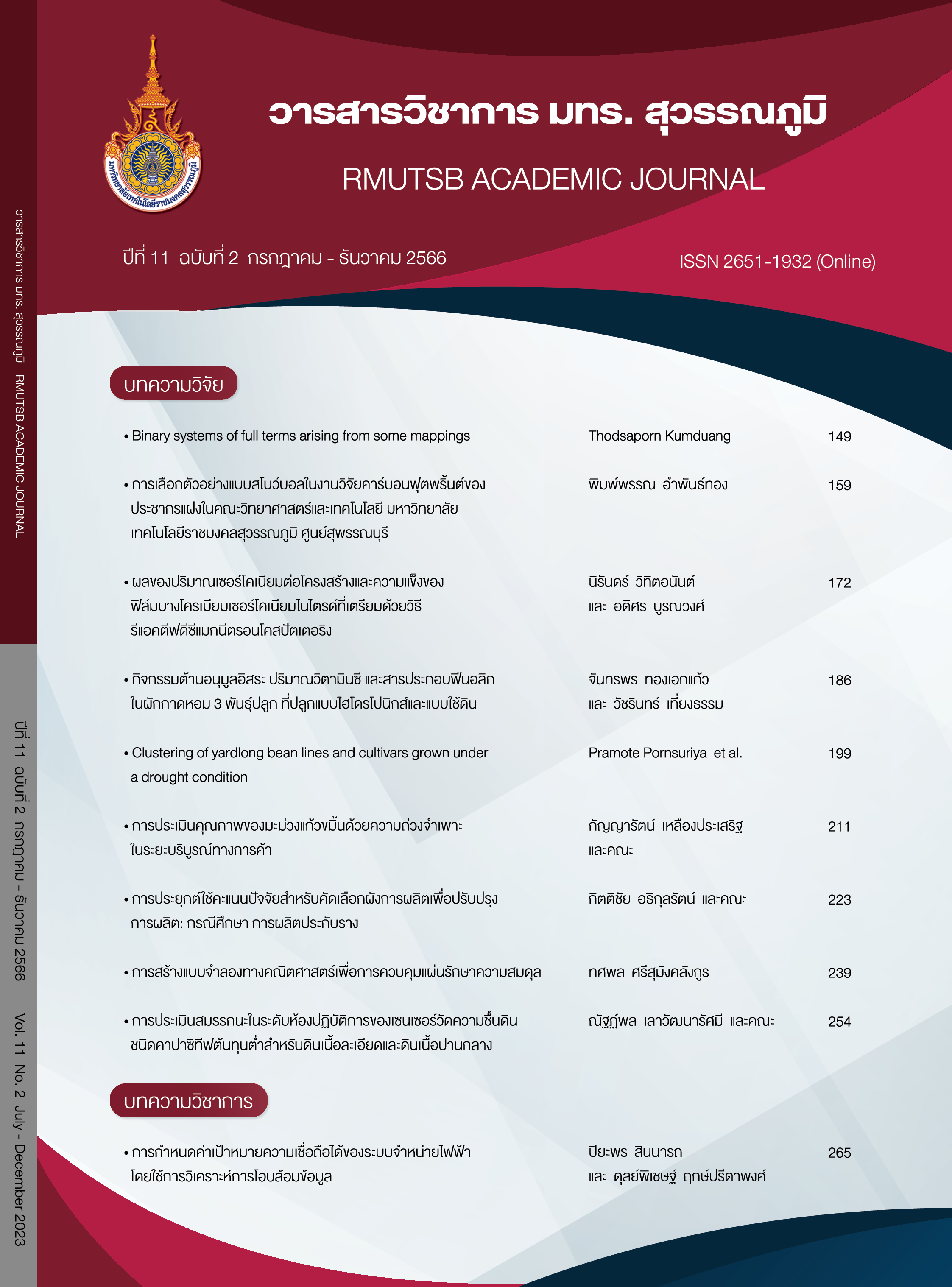Snowball sampling in the carbon footprint research of unregistered populations in the Faculty of Science and Technology, Rajamangala University of Technology Suvarnabhumi, Suphanburi Campus
Main Article Content
Abstract
This research studied the snowball sampling of the unregistered population of environmentalists in the faculty of science and technology from the unregistered population in the faculty. It was found that the snowball sampling was appropriate for a small sample size. The selection of a linear snowball sample was suitable for a maximum size of 20 samples, and the non-discriminatory exponential snowball sample was suitable for maximum size of 16 samples. Carbon footprint emission in the faculty of science and technology was divided into 3 scopes: scope 1, the direct carbon footprint emissions, i.e. traveling to the university (9,312.21 kg CO2e/unit), scope 2, the indirect carbon footprint emissions, i.e. electricity and water consumptions in the faculty (47,768.28 and 176.26 kg CO2e/unit, respectively), and scope 3, the other carbon footprint emissions, such as paper usage, plastic water bottles and paper usage in the faculty (1,132.98, 1,589.86 and 13,504.54 kg CO2e/unit, respectively). In conclusion, the highest emissions of carbon footprint per year of the faculty was the electricity and water usage. Therefore, carbon footprint should be reduced by converting electricity to solar energy, the use of solar cell and incandescent lamps UV and emit less heat, to save electricity costs and to perform a save water campaign in the faculty. In addition, there should be a campaign for planting a tree in the faculty to absorb 9-15 kilograms of carbon dioxide on average. The goal will be set to reduce carbon footprint to zero or net zero by 2 people in the university reduce the temperature as 2-4 degrees Celsius and control the temperature not to rise, as well as expanding the conservative units.
Article Details

This work is licensed under a Creative Commons Attribution-NonCommercial-NoDerivatives 4.0 International License.
Published manuscript are the rights of their original owners and RMUTSB Academic Journal. The manuscript content belongs to the authors' idea, it is not the opinion of the journal's committee and not the responsibility of Rajamangala University of Technology Suvarnabhumi
References
Amphanthong, P., & Busababodhin, P. (2015). Efficiency of parameter estimation methods in multilevel analysis when the sample size is small. Burapha Science Journal, 20(1), 15-24. (in Thai)
Amphanthong, P. (2019). Analysis of water quality in the Suphan Buri River by extreme value theory. RMUTSB Academic Journal, 7(1), 1-19. (in Thai)
Bonkham, P. (2021). COVID-19, the reason why Thailand's carbon emissions have decreased? Retrieved 1 January 2023, from https://urbancreature.co/reenindex-carbondioxide/ (in Thai)
Frank, O., & Snijders, T. (1994). Estimating the size of the hidden populations using snowball sampling. Journal of Official Statistics, 10(1), 53-47.
Keawsawang, N., Amonsanguansin, J., & Sornil, W. (2017). Carbon footprint assessment and sustainable approaches to reducing the greenhouse gas emissions of Thai local administrative organizations: A case study of the Bangkhae District Office, Thailand. Kasetsart Engineering Journal, 30(102), 61-72. (in Thai)
Paliekkawut, W., & Manokhoon, P. (2018). The study of water quality change at Sai-Noi Floating Marketing, Phra Phimonracha canal, Sai-Noi district, Nonthaburi province. RMUTSB Academic Journal, 6(1), 37-44.
Shafie, T. (2010). Design-based estimators for snowball sampling. Retrieved 1 January 2023, from https://ssrn.com/abstract=2471006
Sisamoe, S., & Chainarong, C. (2021). Energy recovery assessment in dairy production process. RMUTSB Academic Journal, 9(2), 199-211. (in Thai)
Thailand Greenhouse Gas Management Organization (Public Organization). (2023). Emission factor of the combustion group of the fuel (stationary combustion) and the combustion of fuel (with movement). Retrieved 12 March 2023, from http://thaicarbonlabel.tgo.or.th/index.php?lang=TH&mod=YjNKbllXNXBlbUYwYVc5dVgyVnRhWE56YVc5dQ. (in Thai)
Voicu, M.-C., & Babonea, A.-M. (2011). Using the snowball method in marketing research on hidden populations. Challenges of the Knowledge Society, 1(1), 1341-1351.


